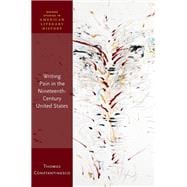Writing Pain in the Nineteenth-Century United States

Writing Pain in the Nineteenth-Century United States
- ISBN 13:
9780192855596
- ISBN 10:
019285559X
- Format: Hardcover
- Copyright: 05/25/2022
- Publisher: Oxford University Press
.svg) Rent
From $65.20
Rent
From $65.20
List Price $89.60 Save
| TERM | PRICE | DUE |
|---|---|---|



List Price $89.60 Save $0.90
Usually Ships in 3-5 Business Days
We Buy This Book Back!
Free Shipping On Every Order
Note: Supplemental materials are not guaranteed with Rental or Used book purchases.
Extend or Purchase Your Rental at Any Time
Need to keep your rental past your due date? At any time before your due date you can extend or purchase your rental through your account.
Summary
Through examining the work of nineteenth-century writers, Constantinesco argues that pain, while undeniably destructive, also generates language and identities, and demonstrates how literature participates in theorizing the problems of mind and body that undergird the deep chasms of selfhood, sociality, gender, and race of a formative period in American history. Writing Pain in the Nineteenth-Century United States considers first Emerson's philosophy of compensation, which promises to convert pain into gain. It also explores the limitations of this model, showing how Jacobs contests the division of body and mind that underwrites it and how Dickinson challenges its alleged universalism by foregrounding the unshareability of pain as a paradoxical measure of togetherness. It then investigates the concurrent economies of affects in which pain was implicated during and after the Civil War and argues, through the example of James and Phelps, for queer sociality as a response to the heteronormative violence of sentimentalism. The last chapter on Alice James extends the critique of sentimental sympathy while returning to the book's premise that pain is generative and the site of thought. By linking literary formalism with individual and social formation, Writing Pain in the Nineteenth-Century United States eventually claims close reading as a method to recover the theoretical work of literature.






